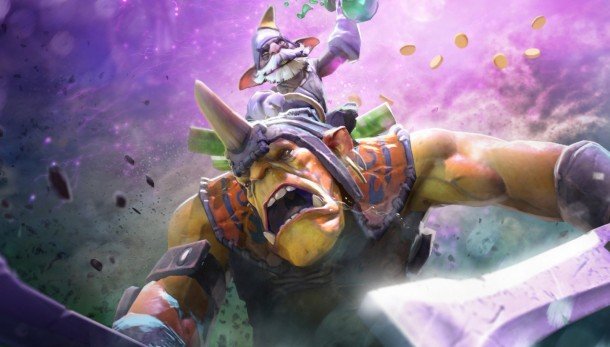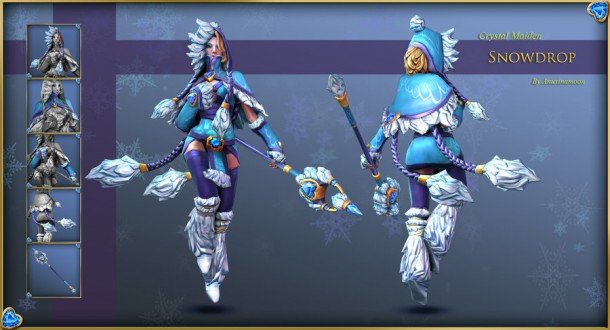Meet the item creators: pro and self-taught artists making millions from Dota 2

Of all the things Valve have done, the 'have-the-community-make-their-own-cosmetics' movement that started with Team Fortress 2, might be the smartest. By creating an ecosystem in which item-makers can profit, Valve have effectively allowed their community to hire itself to expand their game. Though still in beta, Dota 2 enjoys a constant influx of stuff . Every update bristles with new couriers, announcer packs, weaponry and other decorative paraphernalia. With that inevitable release date drawing inexorably closer each day, the momentum of production only seems to be increasing. But, who are the people behind the work?
"It's one of the best, most straightforward ways for 3D artists to profit from what they've made."
To date, item creators have collectively made millions from getting their wares into Valve games. We speak to top item makers who have made significant profits on the Dota 2 workshop, from beginners who have just started modelling with no training, to seasoned professional artists who work for big-budget studios and create Dota 2 items on the side. They say that selling Dota 2 items "it's one of the best, most straightforward ways for 3D artists to profit from what they've made." How did they get started? How do new items come together? How does Valve decide which Steam Workshop items make it into the game? Let's find out.
Getting started as an item-maker isn't a complicated as you might think. Mrpresident's first encounter with a 3D program was a mere 10 months ago when he made his first virtual box. "I was a huge fan of Dota and I'd always wanted to learn how to 3D model," he says "so, I spent a lot of time watching Anuxi and other stream their workflow process on twitch, and tried to practice their techniques and methods."
A firm believer in the educational properties of the twitch streams, mrpresident is one of the many who have taught themselves the art of 3D modeling. Similarly, Vladimir > the implyer , as he is known on Steam, never received a formal education in the field.

"I started modeling early - way before Max 6." Vladimir explains. "I got some books, learned the basics, modeled some teapots and islands made of primitives. At some point, I also began researching some original Half-Life assets, making Morrowind models and it was a lot of fun." Team Fortress 2's hat sales inspired him to start modelling for Valve games. "I always wanted a hat," he says, "but I was kinda late to that party. After the DOTA 2 workshop launched, I decided I should try my hat-making skills there."
Vladimir is arguably one the prolific figures in the Dota 2 workshop community. Clocking in a substantial 259 submissions ("I deleted some stuff, otherwise the count would be closer to 300."), Vladimir has made a name for himself competing with trained, professional 3D artists.
Australia-based Stephanie Everett, otherwise known as Anuxiamoon is one such individual. Her resume encompasses six years of experience in the game industry and big names like Trion Worlds. Of all the contributors, only she alone received the distinct honour of being assigned a 'chest' of her own. Originally too busy to join the ranks of the Dota 2 workshop contributors, Anuxiamoon first began participating in the creation of Dota 2-related items when Polycount announced a competition. She ended up submitting five sets to the event, the last of which made its way into the top ten.
The biggest gaming news, reviews and hardware deals
Keep up to date with the most important stories and the best deals, as picked by the PC Gamer team.

"I had a block of free time open between freelance projects so I took advantage of that and entered the competition. At first, I had no idea what I was doing, but when you do something new, you always have no idea what you're doing, anyway."
"He earns enough to make full-time development of Dota 2 items a viable profession"
Chemical Alia and DrySocket, firm friends and co-conspirators, are veterans of the gaming industry as well. DrySocket claims over nine years of experience in making games. Chemical Alia currently works for a big-budget studio. For DrySocket, the Workshop is a place of experimentation, an avenue to explore quick ideas in his free time. Chemical Alia, on the other hand, began manufacturing items after being requested to produce work for the Dota 2 workshop.
"I originally got into making custom content for Valve games through Team Fortress 2. The TF2 Polycount contest led to a set for a Spy getting into the game, and that was pretty cool." Chemical Alia recalls. "I ended up getting involved in Dota 2 item creation pretty early, with some Valve folks requesting me to make a set of items, which were released alongside the Dota 2 workshop."
Though it might appear otherwise, Dota 2 item creation is serious business. 25% of total sales might not sound like much, at first, but the numbers do add up. Benjamin Retter, also known as BrontoThunder on Steam, says he earns enough from his creations to make full-time development of Dota 2 items a viable profession – a dream come true, for him. With such high stakes in play, it's unsurprising to learn that tensions do exist. Months where only a sparing number of items are accepted can, according to mrpresident, inspire high emotions.

